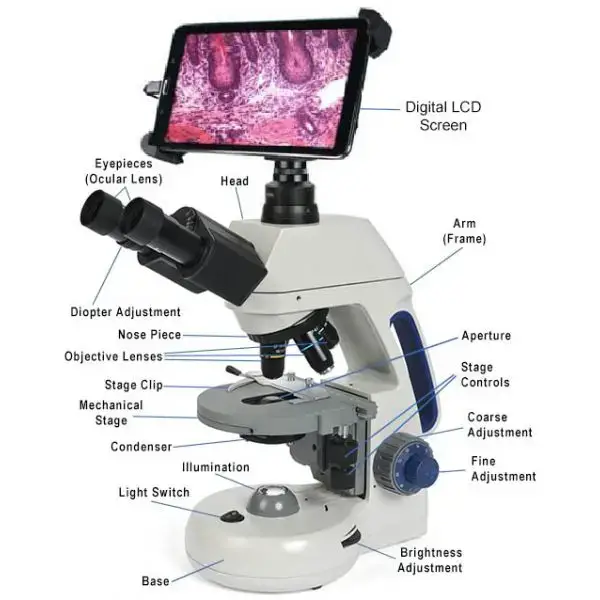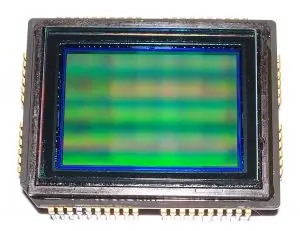What is a Digital Microscope?
A digital microscope is essentially an upgrade from the optical microscope. A digital microscope is an optical microscope with a digital camera and monitor. Therefore, instead of looking through the eyepiece, the user looks at the specimen through a screen. This allows for improved evaluation and later photographic documentation. Whereas a microscope typically relies on external light sources, a digital microscope almost always has internal LED lighting and arrangements that allow for projection straight to a digital sensor. When an image is taken and produced, in many cases, it’s in the moment, allowing the operator to measure, label, or alter the image almost instantaneously. Ranging from cheap to expensive—USB add-ons for at-home enthusiasts and school settings to elaborate industrial and lab setups—a digital microscope is available at every level of use.
The concept of the digital microscope was born in the mid-1980s. In 1986, a Tokyo-based company developed a prototype that connected an analog S-video output to a computer. Throughout the rest of the decade, as digital imaging advanced and connections became increasingly elaborate, many more advanced microscopes came to be—some outfitted with internal computers and monitors. Ultimately, after USB technology was developed, the subsequent digital microscopes were more compact and easier to use in various settings.
Digital Microscope Principle
Digital microscopes contain both the software and hardware necessary to focus on specimens and take images. Utilizing software, users can take images of the specimen projected onto the attached computer monitor. Some software allows for still and motion recording of projected images, after which users can edit, crop, annotate, and save. Similarly, having access to the software allows users to see the images to scale, digitally zoom, and achieve digital manipulation in various ways.
Parts of a Digital Microscope

A digital microscope is essentially exactly what it sounds like: a microscope with a camera to electronically view and observe a specimen and store it for later viewing. The components that make up a digital microscope include:
- Optical system- Lenses and objectives focus light on the specimen to create a magnified image. The better the quality of the lens, the clearer and more focused the image will be.
- Illumination source – LED light sources built into the microscope provide a brighter view in natural light and low light situations.
- Sensor- The sensor, not the eyepiece, captures the image of the magnified specimen. The quality of the sensor (usually measured in pixels) determines the quality of the resulting image.
- Screen- The screen is the microscope/computer screen that displays the image for real-time viewing and real-time testing. Most digital microscopes connect to a computer via USB.
- Processing software – The software is for processing, measurement, and analysis. More professional digital microscopes come with software for stacking images, reconstructing 3D images, and making measurements.
- Mechanical components- The mechanical base, focus mechanism, and stage that holds and moves the slide in place. Many digital models feature motorized stages that allow for more precise adjustment and focus.
In addition to the major components mentioned above, digital microscopes also feature other upgrades for usability and versatility:
- USB Connector. Often, a digital microscope will also include a USB connector for easy plug installation to the computer (functioning similarly to webcams) for picture transfer and use of the device.
- Microtouch Sensor. Sometimes, the digital microscope is a touchscreen where users can take pictures and make adjustments for things like increased LED lighting.
- Scroll Lock. This is a function that enables users to secure their zoomed-in view.
- Magnification Dial. This is an adjustable dial to change the level of magnification on a digital microscope.
- Variable Magnification—digital microscopes provide variable levels of magnification.
- Trinocular Tube—certain models contain a trinocular tube to see through the eyepiece and capture images simultaneously.
- Head—this part houses the microscope’s optical components; interpupillary distance and diopter adjustments help with comfortable viewing.
Types of Digital Microscopes
Many digital microscopes are built and specified based on the specific microscope and user. Many are compact and handheld. Many have industrial and biological applications. The only accessories utilized are a professional digital microscope camera and a PC monitor.
- Digital Microscopes for Biological Applications: These are high powered/high magnification microscopes used for biological applications with a light source below the mechanical stage. The objectives range from 4x to 100x and use LED or halogen light sources.
- Fluorescence Digital Microscope: An optical microscope that operates via fluorescence and phosphorescence as the light source for observation.
- Inverted Digital Microscope: A trinocular digital microscope with a low objective lens below the stage and a light source and condenser located above the stage.
- Metallurgical Digital Microscope: Digital microscopes in a metallurgical setup allow for the observation of metal surfaces or wire circuits and transparent surfaces.
- Phase digital Microscopes: These are upright or inverted microscopes that are used to examine objects that aren’t stained and could be dead or live.
- Stereo Digital Microscope: Stereo digital microscopes shine light on the specimen being observed and are intended for detailed observation of electronic components, antique crafts, electrical circuits, plant materials, and even works of art.
- Polarized Digital Microscope: Polarized digital microscopes are digital microscopes with a standard high-power lens and several super-bright LEDs. These digital microscopes can evaluate and view the quality and composition of anisotropic materials in three-dimensional space. This is done by polarized light, which causes light waves to vibrate in one direction.
- Digital USB Microscope: This is a type of microscope that connects to a computer via USB. It has a fixed camera, unlike many digital microscopes that offer C-mount adapters with removable cameras.
- Handheld Digital Microscope: This type of microscope is the latest technology. Digital microscopes are portable, handheld microscopes. They are for surface observation and can also be used for forensic work.
- Portable Digital Microscopes: These are compact, often wireless, digital microscopes designed to look just below the surface in hard-to-reach places. Their main purpose pertains to medical surfaces, in-situ evaluation, and skin studies.
Operating Procedure of digital microscope
Here is the step by step procedure for operating a digital microscope in laboratory;
- Using a digital microscope is not very different from using a normal microscope. Power on the microscope and the connected computer/camera. Place the slide on the stage and secure it with a clip.
- Adjust the light (most digital microscopes have adjustable lights to various settings, and for a clearer image and more accurate viewing you need to be able to adjust the brightness). Now you’re ready to go.
- To adjust the magnification, change the objective lens for focus or change the digital zoom if applicable. At this point, adjust the coarse and fine knobs to move the specimen in and out and get the focus. The coarse knob gives you the rough focus and the fine knob gives you the exact focus you need.
- Once this focus is set, you can access the still images and videos from the software on the connected computer. After capturing a still image, any other features to measure or access the specimen can be found within the Tools feature of the software.
- Depending on the software you use, some will use a separate program that also provides the ability to annotate the image.
- Ultimately, archive and back up all your photos and data for revisiting. Everything should be saved in a folder so you can access it later.
- Once this is all done, power off the microscope and everything. Be sure to clean everything according to the manufacturer’s specifications to ensure your equipment will function properly for years to come.
How does a digital microscopy work?
In standard digital microscopy, the specimen is initially positioned on the stage. The specimen is then lit according to the required light levels. The light rays reflected from the specimen pass through the objective lens of the microscope to generate an upright image within the microscope tube. Where the CCD (charge-coupled device) is located is where the actual image is created. The CCD processes light rays from this spot to create an enlarged image of the specimen on the monitor screen. If the microscope employs a digital camera as opposed to a CCD, the point at which the intermediate image is created coincides with the focus point of the camera lens.

By expanding the size of the monitor screen, the magnification of the picture produced by the CCD can be enhanced. The specimen’s width, length, diagonal, and circumference can be acquired from the screen itself. Some sophisticated digital microscopes have software for performing these measurements. Digital microscopy aids in acquiring images of various sorts of living and nonliving sample specimens that are crystal clear and of high quality.
Resolution of a digital microscope
A digital microscope having a conventional 2 megapixel CCD generates a picture of 1600×1200 pixels. In this instance, the image resolution relies on the field of view of the camera lens. When the horizontal field of view is divided by 1600, the approximate pixel resolution can be calculated. The resolution of an image can be increased by creating a sub-pixel image.

The Pixel Shift Method is utilised to obtain photographs with a better resolution. In this technology, the CCD is physically moved using an actuator in order to take many overlapping images simultaneously. These numerous images are merged with photos captured by the microscope to provide images with sub-pixel resolution. This method provides sub-pixel information, and averaging a standard image is an established method for obtaining sub-pixel information. Certain software is built specifically to improve the visual resolution displayed on the monitor.
2D measurement
Digital microscopic systems, particularly high-end digital microscopic systems, typically measure the specimen in two dimensions. These measurements are performed on-screen by measuring the distance between two pixels. This is able to provide width, length, diagonal, and circle dimensions as well as additional structural data. Some digital microscopy systems are also capable of particle counting.
3D measurement
Some modern digital microscopy equipment can currently measure in three dimensions. This is accomplished using image stacking. Using a step motor, the microscopic system captures photos of the specimen from the lowest to the highest focal plane inside the field of view of the camera lens. These photos are then reconstructed to generate a 3D model based on image contrast in order to generate a 3D colour image of the specimen.
These 3D models can subsequently be utilised for calculations, although their accuracy is dependent on the step motor and depth of field of the camera lens. Digital microscopy is extensively utilised for a variety of material research applications, including tests with dynamic materials.
Uses of Digital Microscopes
- Digital microscopes help researchers analyze biological samples in detail.
- They assist doctors in diagnosing diseases through tissue analysis.
- Industries use them to inspect materials for defects and quality.
- Students can interact with real-time images for better learning.
- Forensic scientists rely on them to examine evidence like fibers.
- Nanotechnologists study tiny materials using high-resolution imaging.
Advantages of Digital Microscopes
- Expanded Viewing Options- They cast the image on a screen so everyone can enjoy the results.
- Improved Ergonomics: They minimize neck strain as people don’t have to look through an eyepiece to see the slides.
- Greater Image Stability: They provide a more stable image for enhanced analysis.
- Image/Video Recording: They make it possible to take pictures and videos for future use and dissemination.
- User-Friendly: They are easy to use, often with touch screen functionality. Increased Applications: They can be used anywhere from classroom to lab to factory quality control.
- Real-Time Viewing Availability: They provide real-time viewing availability for instantaneous feedback.
- Budget beauties: Some low-cost models still pack a punch.
Limitations of Digital Microscopes
- Unlike traditional microscopes, digital models require a power source.
- They lack the 3D viewing experience provided by eyepieces.
- High magnification can reduce the depth of field, making focusing on three-dimensional objects more challenging.
- Some models can be expensive to manufacture and purchase.
- They may require training for effective use.
- They often rely on software for image processing and analysis.
- Some models have limited possibilities for light adjustments.
- They may have limitations regarding the depth of field and resolution.
Download Digital microscopes software
Jiusion digital microscope software download
Download Celestron digital microscope software
- Text Highlighting: Select any text in the post content to highlight it
- Text Annotation: Select text and add comments with annotations
- Comment Management: Edit or delete your own comments
- Highlight Management: Remove your own highlights
How to use: Simply select any text in the post content above, and you'll see annotation options. Login here or create an account to get started.